最新东南大学研究生英语雅思写作下学期大作业
雅思写作2024年3月小作文

雅思写作2024年3月小作文英文回答:The combination of AI and human capabilities has indeed revolutionized various aspects of our lives. It is an ongoing process that has the potential to further transform our world in numerous ways.Firstly, AI has the ability to enhance humancapabilities by automating routine tasks, freeing up individuals to focus on more complex and creative endeavors. For instance, in the field of medicine, AI-powereddiagnostic tools can assist doctors in analyzing medical images and identifying potential health issues, allowing them to provide more accurate and timely diagnoses. Thisnot only improves patient outcomes but also allows healthcare professionals to spend more time interactingwith patients and providing personalized care.Secondly, AI can augment human intelligence byproviding access to vast amounts of data and information. Through machine learning algorithms, AI systems can sift through large datasets to identify patterns andcorrelations that are often invisible to the human eye. This enhanced intelligence can be leveraged in fields such as finance, where AI-powered algorithms can analyze market data and make predictions, or in scientific research, where AI can assist in the discovery of new drugs and treatments.Thirdly, AI can lead to the development of new products and services that were previously impossible. For instance, in the field of transportation, self-driving cars are a result of the convergence of AI and robotics. These vehicles have the potential to reduce accidents, improve traffic flow, and provide new mobility options for individuals who are unable to drive themselves. Similarly, in the field of entertainment, AI-powered virtual assistants can generate personalized recommendations for movies, music, and other forms of media, enhancing the user experience.However, it is important to note that the integrationof AI and human capabilities is not without its challenges. One major concern is the potential for job displacement as AI systems become more sophisticated and capable of performing tasks that were previously carried out by humans. It is crucial that governments and businesses invest in retraining and upskilling programs to ensure that workers are equipped with the necessary skills to navigate the changing job market.Moreover, there are ethical considerations that need to be addressed as AI becomes more deeply embedded in our lives. For example, the use of AI-powered surveillance systems raises questions about privacy and civil liberties. It is essential that clear regulations and ethicalguidelines are established to ensure that AI is used responsibly and in a manner that respects human rights and values.In conclusion, the integration of AI and human capabilities is a transformative force that has thepotential to reshape our world in profound ways. By leveraging the unique abilities of both humans and machines,we can create a future that is more efficient, intelligent, and inclusive. However, it is important to approach this integration with careful consideration and ensure that we mitigate potential risks and harness the full benefits of this powerful technology.中文回答:人工智能和人类能力的结合确实彻底改变了我们生活的方方面面。
最新东南大学研究生英语雅思写作下学期大作业

On the Delay of Geographical Caching Methods in Two-Tiered Heterogeneous NetworksAbstractWe consider a hierarchical network that consists of mobile users, atwo-tiered cellular network (namely small cellsand macro cells) and central routers, each of which follows a Poisson point process (PPP). Inthis scenario, small cells with limited-capacity backhaul are able to cache content under a given set of randomized caching policies and storage constraints. Moreover, we consider three different content popularity models, namely fixed content popularity, distance-dependent and load-dependent,in order to model the spatio-temporal behavior of users’ content request patterns. We derive expressions for the average delay of users assuming perfect knowledge of content popularity distributions and randomized caching policies. Although the trend of the average delay forall three content popularity models is essentially identical, our results show that the overall performance of cached-enabled heterogeneous networks can be substantially improved, especially under the load dependentcontent popularity model.Besides, Because of the limitation of research conditions, the total network delay, network cost and optimization of network parameters arenot analyzed.Keywords: edge caching, Poisson point process, stochastic geometry, mobile wireless networks, 5GIntroductionIt is known that content caching in 5G heterogeneous wireless networks improves the system performance, and is of high importance in limited-backhaul scenarios. Most existing literature focuses on the characterization of key performance metrics neglecting the backhaul limitations and the spatio-temporal content popularity profiles. In this work, we analyze the gains of caching in heterogeneous network deployment, and consider the average delay as a performance metric.Firstly we use passion point process (PPP) method to build the model. This heterogeneous network consists of mobile terminals (users), cache-enabled s mall base stations (SBSs), macro base stations (MBSs)。
雅思Academic Task范文5篇(中英双语)

雅思Academic Task范文5篇(中英双语)第一篇:题目背景(Background):假设任务一是关于描述柱状图,图表显示了不同国家的人口增长情况。
英文范文(English Version):The given bar chart illustrates the population growth in various countries over a period of 50 years from 1970 to 2020. The countries included in the chart are China, India, the United States, Brazil, and Nigeria.From the chart, it is evident that China had the largest population in 1970, with approximately 800 million people. Over the next five decades, China's population steadily increased, reaching a peak of around 1.4 billion by 2020.India, on the other hand, had the second-largest population in 1970, with approximately 600 million people. Unlike China, India's population growth was more rapid, surpassing China's population in the early 2000s. By 2020, India had the highest population among the countries shown in the chart, with nearly 1.5 billion people.The United States, Brazil, and Nigeria had significantly smaller populations in 1970, ranging from 100 million to 150 million people. Over the years, all three countries experienced population growth, with the United States and Brazil showing relatively steady increases, whileNigeria's population surged rapidly. By 2020, the United States had a population of approximately 330 million, Brazil had around 220 million, and Nigeria had nearly 250 million.In conclusion, the bar chart highlights the population growth trends in China, India, the United States, Brazil, and Nigeria over a 50-year period. China and India, in particular, witnessed substantial increases in their populations, with India eventually surpassing China as the most populous country by 2020.中文范文(Chinese Version):给定的柱状图展示了从1970年到2020年50年间各个国家的人口增长情况。
雅思写作大作文范文 雅思写作讨论双方观点 university subjects大学科目.doc

雅思写作大作文范文雅思写作讨论双方观点 university subjects大学科目今天我们雅思写作大作文范文的文章来研究下大学科目。
随着最近几年经济形势的下滑,就业一再成为新闻媒体报道的焦点。
有些同学表示,自己在大学学的东西高大上是高大上,但一点用处都没有。
当初还不如学一些好就业的学科。
但也有同学表示自己在过去的四年里学到了自己喜欢的东西。
虽然有一定概率毕业的时候不那么吃香,但只要做自己喜欢的事情,总有一天会变好的。
那么大学究竟是应该让学生根据自己的兴趣爱好选择专业呢?还是只提供有用的课程呢?小编搜集了一篇相应的考官范文,以供大家参考。
雅思写作大作文题目Some people think that all university students should study whatever they like. Others believe that they should only be allowed to study subjects that will be useful in the future, such as those related to science and technology. Discuss both these views and give your own opinion.一些人认为所有的大学学生应该学习他们喜欢的东西。
其他人则认为他们应该只能学习未来有用的学科,比如与科学和技术相关的那些。
讨论双方观点,并给出你自己的意见。
雅思写作大作文范文People have different views about how much choice students should have with regard to what they can study at university. While some argue that it would be better for students to be forced into certain key subject areas, I believe that everyone should be able to study the course of their choice.人们对于学生在大学中拥有多大的自由去选择自己所学的东西有不同的意见。
东南大学《理解当代中国英语演讲》2023-2024学年第一学期期末试卷
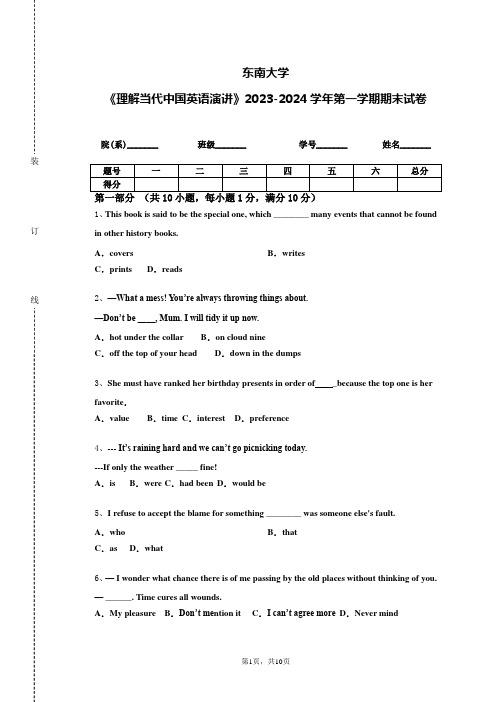
东南大学《理解当代中国英语演讲》2023-2024学年第一学期期末试卷院(系)_______ 班级_______ 学号_______ 姓名_______1、This book is said to be the special one, which ________ many events that cannot be found in other history books.A.covers B.writesC.prints D.reads2、—What a mess! You’re always throwing things about.—Don’t be ____, Mum. I will tidy it up now.A.hot under the collar B.on cloud nineC.off the top of your head D.down in the dumps3、She must have ranked her birthday presents in order of _because the top one is her favorite.A.value B.time C.interest D.preference4、--- It’s raining hard and we can’t go picnicking today.---If only the weather _____ fine!A.is B.were C.had been D.would be5、I refuse to accept the blame for something ________ was someone else's fault.A.who B.thatC.as D.what6、— I wonder what chance there is of me passing by the old places without thinking of you.— ______. Time cures all wounds.A.My pleasure B.Don’t me ntion it C.I can’t agree more D.Never mind7、You’ll recognize me when you get out of the station. I______ jeans and a white T-shirt. A.will be wearing B.had wornC.was wearing D.have worn8、During ______ afternoon, the rain became smaller, but towards__________ evening, there was a sudden landslide that buried the village.A./; the B.the; / C.the; the D.an; the9、Within even the weakest of human bodies lies a life that is precious indeed--- ____ needs to be respected and honored.A.something that B.one C.one that D.something10、The college examination is ________________ easier this year than I have expected. A.fairly B.quiteC.rather D.very第二部分阅读理解(满分20分)阅读下列短文,从每题所给的A、B、C、D 四个选项中,选出最佳选项。
【第44期】雅思大作文8分范文中英对照及关键句型
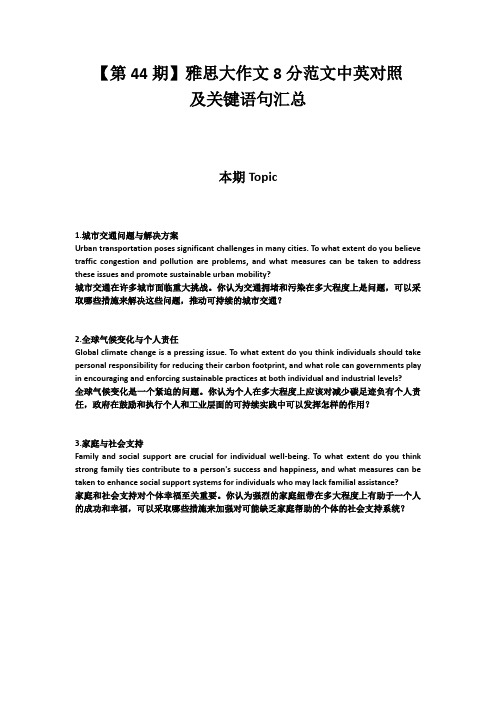
【第44期】雅思大作文8分范文中英对照及关键语句汇总本期Topic1.城市交通问题与解决方案Urban transportation poses significant challenges in many cities. To what extent do you believe traffic congestion and pollution are problems, and what measures can be taken to address these issues and promote sustainable urban mobility?城市交通在许多城市面临重大挑战。
你认为交通拥堵和污染在多大程度上是问题,可以采取哪些措施来解决这些问题,推动可持续的城市交通?2.全球气候变化与个人责任Global climate change is a pressing issue. To what extent do you think individuals should take personal responsibility for reducing their carbon footprint, and what role can governments play in encouraging and enforcing sustainable practices at both individual and industrial levels?全球气候变化是一个紧迫的问题。
你认为个人在多大程度上应该对减少碳足迹负有个人责任,政府在鼓励和执行个人和工业层面的可持续实践中可以发挥怎样的作用?3.家庭与社会支持Family and social support are crucial for individual well-being. To what extent do you think strong family ties contribute to a person's success and happiness, and what measures can be taken to enhance social support systems for individuals who may lack familial assistance?家庭和社会支持对个体幸福至关重要。
2021年11月36日雅思写作范文
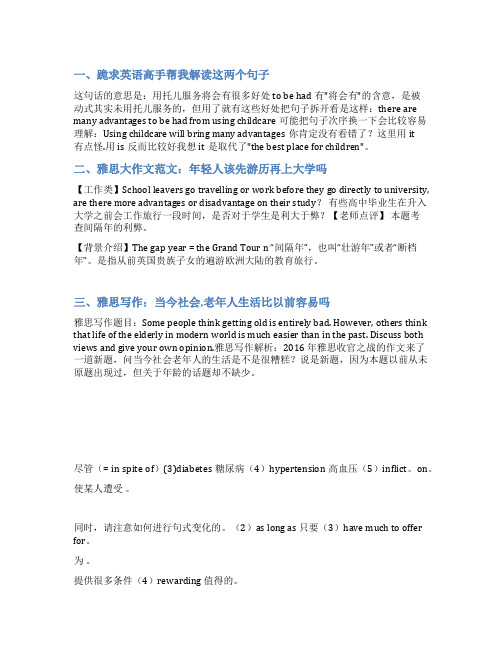
一、跪求英语高手帮我解读这两个句子这句话的意思是:用托儿服务将会有很多好处to be had有"将会有"的含意,是被动式其实未用托儿服务的,但用了就有这些好处把句子拆开看是这样:there are many advantages to be had from using childcare可能把句子次序换一下会比较容易理解:Using childcare will bring many advantages你肯定没有看错了?这里用it有点怪.用is反而比较好我想it是取代了"the best place for children"。
二、雅思大作文范文:年轻人该先游历再上大学吗【工作类】School leavers go travelling or work before they go directly to university, are there more advantages or disadvantage on their study?有些高中毕业生在升入大学之前会工作旅行一段时间,是否对于学生是利大于弊?【老师点评】本题考查间隔年的利弊。
【背景介绍】The gap year = the Grand Tour n “间隔年”,也叫“壮游年”或者“断档年”。
是指从前英国贵族子女的遍游欧洲大陆的教育旅行。
三、雅思写作:当今社会,老年人生活比以前容易吗雅思写作题目:Some people think getting old is entirely bad. However, others think that life of the elderly in modern world is much easier than in the past. Discuss both views and give your own opinion.雅思写作解析:2016 年雅思收官之战的作文来了一道新题,问当今社会老年人的生活是不是很糟糕?说是新题,因为本题以前从未原题出现过,但关于年龄的话题却不缺少。
2024年度雅思写作雅思大作文高分范文及题型

2024/3/24
20
检查与修改技巧
检查语法和拼写错误
确保文章语言准确、规范。
2024/3/24
检查逻辑连贯性
确保文章各部分之间逻辑严密 ,无跳跃或重复。
调整句式和词汇
根据需要调整句式结构和词汇 选择,提升文章的流畅度和可 读性。
注意字数和时间
确保在规定时间内完成写作, 并控制文章字数在合理范围内
23
词汇使用不当剖析
词汇选择不准确
在写作中,应该使用最 准确、最生动的词汇来 表达思想,避免使用模 糊或笼统的词汇。
2024/3/24
词汇搭配不当
英语中有些词汇习惯上 只能和某些特定的词搭 配使用,如果搭配不当 ,会造成句子意思不清 或语法错误。
重复使用同一词汇
在写作中,应该尽量使 用多样化的词汇来表达 思想,避免重复使用同 一词汇,以免造成语言 单调乏味。
雅思写作雅思大作文 高分范文及题型
2024/3/24
1
目 录
2024/3/24
• 引言 • 雅思大作文题型分类 • 高分范文解析与欣赏 • 写作技巧与策略指导 • 常见错误与问题剖析 • 模拟练习与实战演练
2
01
引言
2024/3/24
3
雅思写作考试概述
雅思写作考试是评估考生英语写作能力的重要标准,要求考生在规定时间内完成两 篇作文。
信息准确,客观中立
报告文需要提供准确、客观的信息和数据,避免主观色彩和个人 情感。
语言简练,表达规范
高分报告文需要使用简练、规范的语言表达,避免冗余和复杂的 句子结构。
14
图表作文高分范文
2024/3/24
雅思c11-t3大作文,范文
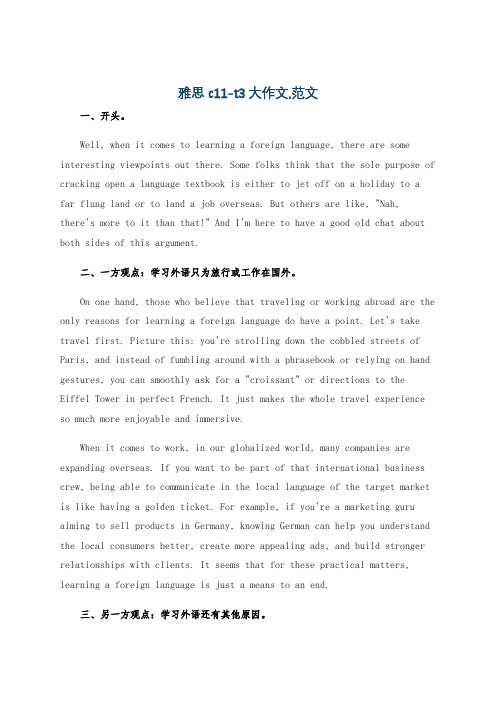
雅思c11-t3大作文,范文一、开头。
Well, when it comes to learning a foreign language, there are some interesting viewpoints out there. Some folks think that the sole purpose of cracking open a language textbook is either to jet off on a holiday to afar flung land or to land a job overseas. But others are like, "Nah,there's more to it than that!" And I'm here to have a good old chat about both sides of this argument.二、一方观点:学习外语只为旅行或工作在国外。
On one hand, those who believe that traveling or working abroad are the only reasons for learning a foreign language do have a point. Let's take travel first. Picture this: you're strolling down the cobbled streets of Paris, and instead of fumbling around with a phrasebook or relying on hand gestures, you can smoothly ask for a "croissant" or directions to theEiffel Tower in perfect French. It just makes the whole travel experience so much more enjoyable and immersive.When it comes to work, in our globalized world, many companies are expanding overseas. If you want to be part of that international business crew, being able to communicate in the local language of the target market is like having a golden ticket. For example, if you're a marketing guru aiming to sell products in Germany, knowing German can help you understand the local consumers better, create more appealing ads, and build stronger relationships with clients. It seems that for these practical matters, learning a foreign language is just a means to an end.三、另一方观点:学习外语还有其他原因。
雅思作文stem field
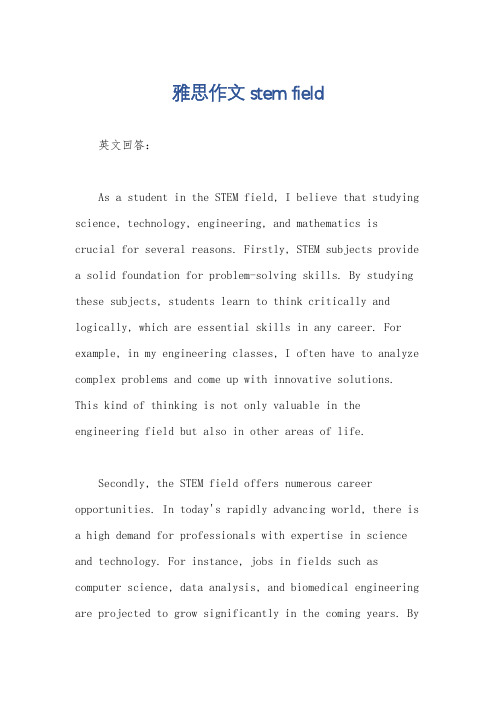
雅思作文stem field英文回答:As a student in the STEM field, I believe that studying science, technology, engineering, and mathematics iscrucial for several reasons. Firstly, STEM subjects provide a solid foundation for problem-solving skills. By studying these subjects, students learn to think critically and logically, which are essential skills in any career. For example, in my engineering classes, I often have to analyze complex problems and come up with innovative solutions. This kind of thinking is not only valuable in the engineering field but also in other areas of life.Secondly, the STEM field offers numerous career opportunities. In today's rapidly advancing world, there is a high demand for professionals with expertise in science and technology. For instance, jobs in fields such as computer science, data analysis, and biomedical engineering are projected to grow significantly in the coming years. Bystudying STEM subjects, students can position themselvesfor a successful and fulfilling career.Furthermore, the STEM field fosters innovation and drives technological advancements. Many of the world's most significant breakthroughs and inventions have come from individuals with a strong background in STEM. For instance, the development of smartphones and the internet revolutionized the way we communicate and access information. By studying STEM, students can contribute to the creation of new technologies and make a positive impact on society.In conclusion, studying STEM subjects is essential for developing problem-solving skills, accessing a wide range of career opportunities, and driving technological advancements. By immersing ourselves in the STEM field, we can become critical thinkers, contribute to innovation, and shape the future.中文回答:作为一名STEM领域的学生,我相信学习科学、技术、工程和数学对于几个方面至关重要。
2021年8月8日雅思大作文范文

12月2日雅思大作文真题:老建筑应该被拆除吗关于老建筑物的价值及其是否该拆除,这是个绝对的老题,唐老师在雅思写作教学和讲座中曾多次以本题为例讲雅思写作的基本思路。
那么城市中的老建筑物是否应该拆除?可能有些同学会用一边倒的思维方式来思考这个题目,认为不应该拆除老建筑物,因为这些建筑物有历史和文化价值,应该保留。
这个思路不错,但接下去怎么写呢?这些同学可能就开始懵圈了,因为实在很难找到保留老建筑物的其他理由了。
其实,如果打开思路,我们就会发现,对某些人来说,城市里的老建筑物是应该拆除的,因为抛开历史文化价值,这些老建筑物的确没有实用价值,它们占据着城市的有限空间,既不能居住,也不能为我们的生活提供任何便利,同时维护不好的话,还可能给居民带来危险。
因此,就本题而言,我们可以开始论述应该拆除老建筑物的理由,然后再论述保留老建筑物的理由(同时回答老建筑物对我们的重要意义),最后得出结论:保留老建筑物也许并不能给我们带来实际的生活好处,但其历史和文化价值是不能忽略的。
01 Every city has old buildings. Now the question is: how to deal with these old buildings? Some people think they should be pulled downandreplaced with new ones, while others believe they should be preserved and protected.每个城市都有老建筑。
现在的问题是:如何处理这些老建筑?有些人认为他们应该被推倒,用新建筑取而代之,而另一些人则认为它们应该得到保留和保护。
首先,老建筑不再适合人们居住,因此,它们应该被摧毁,并让位于新建筑,这样城里的人们(尤其是年轻人)才有更多的居住空间。
其次,旧建筑会给城市居民带来不便。
因为没有穿过旧建筑的直路,人们有时不得不绕过它们走很长的路去上下班,这样就浪费了他们很多时间。
雅思大作文题目及参考范文XX

雅思大作文题目及参考范文XX大家都知道现在环境污染严重,造成环境污染的原因是什么?面对环境污染我们应该怎么做?面是的英语作文,大家可以参考参考。
Humans are responsible for a variety of environmental problems, but we can also take steps to reduce the damage that we are causing to the pla. This essay will discuss environmental problems and the measures that governments and individuals can take to address these problems.Two of the biggest threats to the environment are air pollution and waste. Gas emissions from factories and exhaust fumes from vehicles lead to global warming, which may have a devastating effect on the pla in the future. As the human population increases, we are also producing ever greater quantities of waste, which contaminates the earth and pollutes rivers and oceans.Governments could certainly make more effort to reduce air pollution. They could introduce laws to limit emissions from factories or to force panies to use renewable energy from solar, wind or water power. They could also impose‘green taxes’ on drivers and airline panies. In this way, people would be encouraged to use public transport and to take fewer flights abroad, therefore reducing emissions.Individuals should also take responsibility for the impact they have on the environment. They can take public transport rather than driving, choose products with lesspackaging, and recycle as much as possible. Most supermarkets now provide reusable bags for shoppers as well as ‘banks’ for recycling glass, plastic and paper intheir car parks. By reusing and recycling, we can help to reduce waste.In conclusion, both national governments andindividuals must play their part in looking after the environment.It is no doubt true that the majority of people would like to be happy in their lives. While the personal nature of happiness makes it difficult to describe, there do seem to be some mon needs that we all share with regard to experiencing or achieving happiness.Happiness is difficult to define because it means something different to each individual person. Nobody can fully underst and or experience another person’s feelings, and we all have our own particular passions from which we take pleasure. Some people, for example, derive a sense of satisfaction from earning money or achieving suess, whereas for others, health and family are much more important. At the same time, a range of other feelings, from excitement to peacefulness, may be associated with the idea of happiness, and the same person may therefore feel happy in a variety of different ways.Although it seems almost impossible to give a precise definition of happiness, most people would agree that there are some basic preconditions to achieving it. Firstly, itis hard for a person to be happy if he or she does not have a safe place to live and enough food to eat. Our basic survival needs must surely be met before we can lead a pleasant life. Secondly, the greatest joy in life isusually found in shared experiences with family and friends, and it is rare to find a person who is content to live in plete isolation. Other key factors could be individual freedom and a sense of purpose in life.In conclusion, happiness is difficult to define because it is particular to each individual, but I believe that our basic needs for shelter, food and pany need to be fulfilled before we can experience it.。
3.16雅思大作文
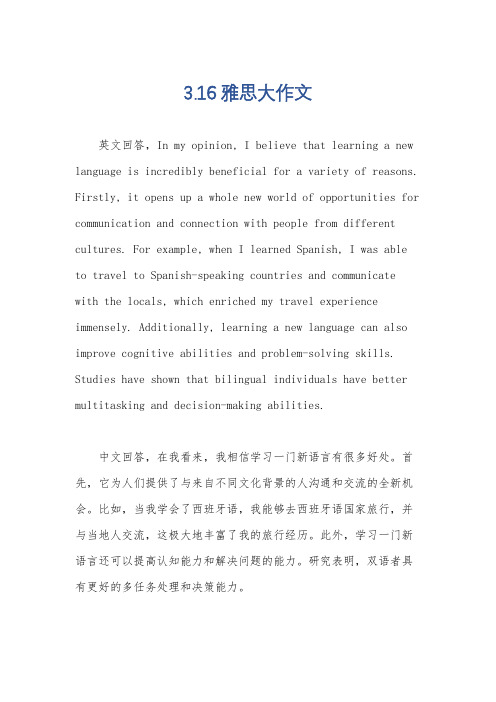
3.16雅思大作文英文回答,In my opinion, I believe that learning a new language is incredibly beneficial for a variety of reasons. Firstly, it opens up a whole new world of opportunities for communication and connection with people from different cultures. For example, when I learned Spanish, I was able to travel to Spanish-speaking countries and communicate with the locals, which enriched my travel experience immensely. Additionally, learning a new language can also improve cognitive abilities and problem-solving skills. Studies have shown that bilingual individuals have better multitasking and decision-making abilities.中文回答,在我看来,我相信学习一门新语言有很多好处。
首先,它为人们提供了与来自不同文化背景的人沟通和交流的全新机会。
比如,当我学会了西班牙语,我能够去西班牙语国家旅行,并与当地人交流,这极大地丰富了我的旅行经历。
此外,学习一门新语言还可以提高认知能力和解决问题的能力。
研究表明,双语者具有更好的多任务处理和决策能力。
2024年3月雅思纸笔作文

2024年3月雅思纸笔作文英文回答:As we approach the year 2024, it is important to consider the future of the IELTS exam and how it will continue to evolve. The IELTS exam has been a widely recognized and respected test for English proficiency for many years, and it is likely that it will continue to be so in the future.One possible change that could occur in 2024 is the integration of technology into the exam. With the rapid advancements in technology, it is possible that the IELTS exam could become more interactive and immersive. For example, instead of writing essays by hand, test takers may be required to type their responses on a computer or tablet. This would not only make the exam more efficient, but it would also better reflect the real-life situations where English is used in a digital format.Another potential change could be the inclusion of more real-life scenarios in the speaking section of the exam. Currently, test takers are asked to discuss a variety of topics, but these topics are often abstract and unrelated to everyday life. In 2024, it is possible that the speaking section could include more practical scenarios, such as discussing a recent trip or describing a memorable experience. This would not only make the exam more engaging for test takers, but it would also better assess their ability to communicate effectively in real-life situations.Overall, the future of the IELTS exam in 2024 is likely to see advancements in technology and a greater emphasis on real-life scenarios. These changes would not only make the exam more relevant and practical, but they would alsobetter assess a test taker's English proficiency.中文回答:2024年临近,我们需要考虑雅思考试的未来以及它将如何继续发展。
2024年3月9日雅思小作文题
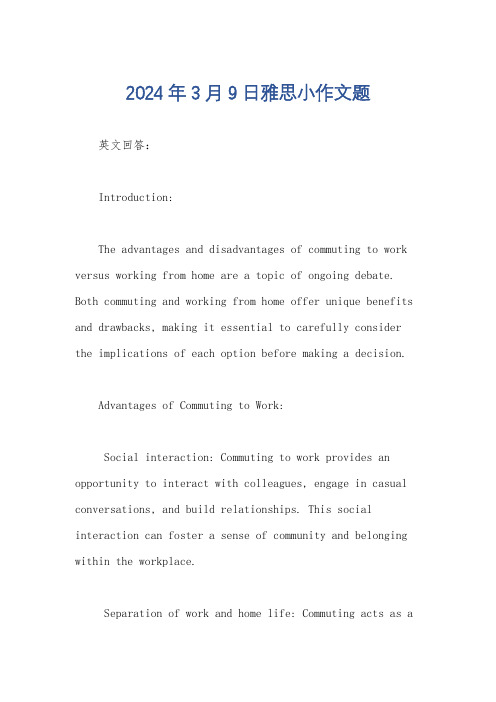
2024年3月9日雅思小作文题英文回答:Introduction:The advantages and disadvantages of commuting to work versus working from home are a topic of ongoing debate. Both commuting and working from home offer unique benefits and drawbacks, making it essential to carefully consider the implications of each option before making a decision.Advantages of Commuting to Work:Social interaction: Commuting to work provides an opportunity to interact with colleagues, engage in casual conversations, and build relationships. This social interaction can foster a sense of community and belonging within the workplace.Separation of work and home life: Commuting acts as aphysical and psychological boundary between the workspace and the home environment. This separation can help maintain a healthier work-life balance and reduce the risk of work-related stress spilling over into personal life.Structured routine: The regular schedule of commuting can provide a sense of structure and discipline to the workday. It establishes clear start and end times, which can help manage time more effectively.Disadvantages of Commuting to Work:Time-consuming: Commuting can be a significant time investment, especially in large cities or congested areas. This time could be better spent on work-related tasks, personal errands, or leisure activities.Stressful: Commuting can often be stressful due to traffic congestion, delays, and unpredictable travel conditions. This stress can negatively impact both physical and mental well-being.Environmental impact: Commuting by car contributes to traffic congestion and air pollution, which can have detrimental effects on the environment.Advantages of Working from Home:Flexibility: Working from home offers greaterflexibility in terms of work hours, location, and workload. This can be particularly beneficial for individuals with family responsibilities or those seeking a more flexible work-life balance.Increased productivity: Studies have shown that employees who work from home can be more productive due to fewer distractions, a more comfortable work environment, and the ability to work at their peak performance times.Cost savings: Working from home can save on commuting expenses, such as gas, public transportation, and parking. Additionally, it reduces the need for work-related wardrobe expenses.Disadvantages of Working from Home:Social isolation: Working from home can lead to social isolation, as individuals may have fewer opportunities to interact with colleagues and build workplace relationships.Lack of structure: The absence of a physical workplace can make it challenging to establish a structured workday. This can lead to procrastination and difficulty maintaining motivation.Technical challenges: Working from home relies on reliable internet and technology, which can be a source of frustration and downtime if not functioning properly.Conclusion:The decision of whether to commute to work or work from home is a personal one that depends on individual circumstances and preferences. Both options offer advantages and disadvantages, and the best choice will vary depending on factors such as work demands, lifestyle, andpersonal values. Carefully weighing the pros and cons of each option will help individuals make an informed decision that aligns with their goals and aspirations.中文回答:通勤上班与在家工作的利弊。
雅思大作文2021.9.4

雅思大作文2021.9.4英文回答:In the contemporary era, with the advent of technological advancements, many argue that manual skills and crafts are becoming increasingly obsolete. While it is true that automation and digitization have streamlined certain tasks, the value of manual skills and crafts remains undeniable.Firstly, manual skills and crafts foster creativity and innovation. The act of working with one's hands, manipulating materials, and creating something tangible stimulates the imagination and encourages problem-solving. This enhances cognitive development and allows individuals to express themselves in unique ways.Secondly, manual skills and crafts promote dexterity and coordination. Engaging in these activities requiresfine motor control, hand-eye coordination, and spatialreasoning skills. By honing these abilities, individuals improve their overall physical capabilities and develop a sense of precision.Thirdly, manual skills and crafts preserve cultural heritage. Many traditional cultures are closely tied to the production of handcrafted objects, such as textiles, pottery, and sculptures. These objects carry historical and cultural significance, providing a tangible link to past generations. By preserving and passing down these skills, we safeguard our cultural identity.While automation may have reduced the demand forcertain manual skills in specific industries, it has also created new opportunities in others. For instance, 3D printing and computer-aided design have opened up new avenues for artisans and craftspeople to create innovative products.Moreover, manual skills and crafts provide therapeutic benefits. Engaging in these activities can reduce stress, improve focus, and enhance well-being. The tactile andsensory experiences involved in working with materials can have a calming and restorative effect on the mind and body.In conclusion, manual skills and crafts remain highly valuable in the digital age. They foster creativity, promote dexterity, preserve cultural heritage, and provide therapeutic benefits. By embracing and supporting these skills, we not only enrich our lives but also ensure the continuation of traditional cultural practices that connect us to our past and shape our future.中文回答:在技术进步的当代,许多人认为手工技能和工艺正变得越来越过时。
雅思作文5.5范文
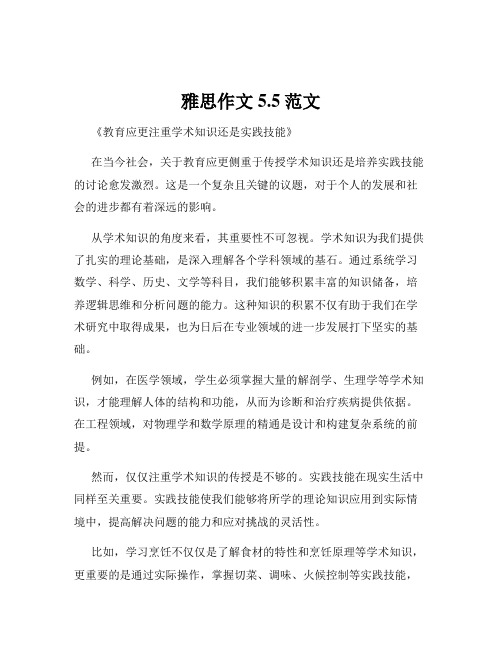
雅思作文5.5范文《教育应更注重学术知识还是实践技能》在当今社会,关于教育应更侧重于传授学术知识还是培养实践技能的讨论愈发激烈。
这是一个复杂且关键的议题,对于个人的发展和社会的进步都有着深远的影响。
从学术知识的角度来看,其重要性不可忽视。
学术知识为我们提供了扎实的理论基础,是深入理解各个学科领域的基石。
通过系统学习数学、科学、历史、文学等科目,我们能够积累丰富的知识储备,培养逻辑思维和分析问题的能力。
这种知识的积累不仅有助于我们在学术研究中取得成果,也为日后在专业领域的进一步发展打下坚实的基础。
例如,在医学领域,学生必须掌握大量的解剖学、生理学等学术知识,才能理解人体的结构和功能,从而为诊断和治疗疾病提供依据。
在工程领域,对物理学和数学原理的精通是设计和构建复杂系统的前提。
然而,仅仅注重学术知识的传授是不够的。
实践技能在现实生活中同样至关重要。
实践技能使我们能够将所学的理论知识应用到实际情境中,提高解决问题的能力和应对挑战的灵活性。
比如,学习烹饪不仅仅是了解食材的特性和烹饪原理等学术知识,更重要的是通过实际操作,掌握切菜、调味、火候控制等实践技能,才能做出美味的菜肴。
在职业教育中,像汽车维修、木工等专业,学生需要通过大量的实际操作练习,才能熟练掌握维修和制作的技巧。
此外,实践技能还有助于培养创新精神和创造力。
当我们在实践中遇到问题时,往往需要突破传统的思维模式,寻找新的解决方案。
这种创新能力在当今快速发展的社会中尤为重要。
综上所述,教育不应单纯侧重于学术知识或实践技能,而应寻求两者的平衡。
在学校教育中,可以增加实践课程的比例,为学生提供更多动手操作的机会。
同时,教师也应该引导学生将学术知识与实践技能相结合,鼓励他们在实践中运用所学的理论知识。
对于个人而言,我们也应该意识到自身发展的需求,在学习学术知识的同时,积极主动地参与实践活动,提高自己的综合能力。
只有这样,我们才能更好地适应社会的发展和变化,为自己的未来创造更多的机会。
- 1、下载文档前请自行甄别文档内容的完整性,平台不提供额外的编辑、内容补充、找答案等附加服务。
- 2、"仅部分预览"的文档,不可在线预览部分如存在完整性等问题,可反馈申请退款(可完整预览的文档不适用该条件!)。
- 3、如文档侵犯您的权益,请联系客服反馈,我们会尽快为您处理(人工客服工作时间:9:00-18:30)。
On the Delay of Geographical Caching Methods in Two-Tiered Heterogeneous NetworksAbstractWe consider a hierarchical network that consists of mobile users, a two-tiered cellular network (namely small cellsand macro cells) and central routers, each of which follows a Poisson point process (PPP). In this scenario, small cells with limited-capacity backhaul are able to cache content under a given set of randomized caching policies and storage constraints. Moreover, we consider three different content popularity models, namely fixed content popularity, distance-dependent and load-dependent,in order to model the spatio-temporal behavior of users’ content request patterns. We derive expressions for the average delay of users assuming perfect knowledge of content popularity distributions and randomized caching policies. Although the trend of the average delay for all three content popularity models is essentially identical, our results show that the overall performance of cached-enabled heterogeneous networks can be substantially improved, especially under the load dependentcontent popularity model.Besides, Because of the limitation of research conditions, the total network delay, network cost and optimization of network parameters are not analyzed.Keywords: edge caching, Poisson point process, stochastic geometry, mobile wireless networks, 5GIntroductionIt is known that content caching in 5G heterogeneous wireless networks improves the system performance, and is of high importance in limited-backhaul scenarios. Most existing literature focuses on the characterization of key performance metrics neglecting the backhaul limitations and the spatio-temporal content popularity profiles. In this work, we analyze the gains of caching in heterogeneous network deployment, and consider the average delay as a performance metric.Firstly we use passion point process (PPP) method to build the model. This heterogeneous network consists of mobile terminals (users), cache-enabled small base stations (SBSs), macro base stations (MBSs)and central routers. In this network setting, a user may experience delays due to downlink transmissions, backhaul and caches.Moreover, in order to capture the spatio-temporal content access patterns of users, we suppose fixed content popularity, distance-dependent and load-dependent content popularities. Assuming that the content popularity distribution is perfectly known at the small base stations, we explore three different caching policies based on content-popularity and randomization. And finally, we draw our conclusion.MethodologyFirst, our Research objective is to get the average delay in a cache-enabled two-tiered cellular network modeled by stochastic geometry, the figure one is an illustration of the considered system model, the methodology part including the following parts.The first is the topology, the central routers, MBSs, SBSs, USERs are modeled by the independent PPP models, the second is the signal model, for the tractability for the problem, we assume that the typical user experience the rayleigh fading and the standard power law path loss, also we assume that the network is interference-limited, that is to say the interference power dominates over the noise power.Then it is the caching model, when a user has a content request, we assume that the request is drawn from a continuous zipf distribution, in the function, there is a content popularity parameter, based on this parameter, we have three caching models, Fixed means that the content popularity is identical for all users, all SBSs observe the same distribution, Distance-dependent means that each user has a distance-dependent steepness factor ,the factor is related to the average distance between the SBS and its users.Based on the caching models, here we consider three caching policies: StdPop means the SBSs cache the most popular content from the catalogue, the Unirand means the contents are cached uniformly at random, the MixPop policy means that part storage cache the most popular contents, the other part cache the content at random.The last part is the delay, our metric in this paper, the delay including the following three parts, When the BSs deliver the contents to their intended mobile users, it incurs the downlink delay, When the content requested are not cached in the BSs, the BSs have to get the content form the central routers through the backhaul, then it causes delay, when the content requested in the caches, the content need to be taken out from the caches, it causes delay.Reporting and Discussing ResultsIn this section, we numerically validate our approximations derived in the previous section. The impact of critical system parameters are discussed as follows.Fig. (a) Impact of MBS density. (b) Impact of small cell density.(c) Impact of target SIR. (d) Impact of storage size.Impact of MBS density λmc:The change of average delay with respect to the MBSdensity is given in Fig. a. Therein, as the number of MBSs increases, we observe an increment in average delay at millisecond level. This is mainly due to the backhaul as the delay in backhaul is proportional to the distance and average number of connected MBSs. On the other hand, the average delay in SBSs remains static in this setup. However, we note that the average delay experienced by a typical small cell user is reduced by adding caching capabilities at the base stations.Impact of small cell density λsc: The change of the average delay with respect to the small cell density is depicted in Fig. b. Similarly to the previous figure for MBS density, we see that the average delay increases for all kind of small cell users. However, in this numerical setup, the rateof increment in delay with no-caching capabilities at the SBSs is higher than the delay experienced by the typical users with cache- enabled SBSs. Compared to the fixed and load-dependent content popularities, the typical user under load-dependent content popularity experiences less delay when the number of SBSs increases.Impact of target SIRγ: In our setup, yet another important design parameter is the target SIR. In this regard, the average delay variation with respect to the target SIR is illustrated in Fig. 2c. As observed in the figure, the average delay increases by imposing higher target SIR values. This change is only visible in low values of target SIR, whereas the variation of delay in higher values of target SIR is negligible. This might stem from the fact that the downlink delay is not a dominating factor in our scenario compared to the backhaul delay. A typical user connected to the small cell with no caching capabilities experiences the highest delay, whereas the minimum delay is achieved by using MixPop policy under load-dependent content popularity. The delay of a typical MU remains between a SU with no-caching and caching capabilities at the base stations.Impact of storage size S: Yet another crucial design parameter in our setup is the storage size. The impact of storage size on the average delay is shown in Fig. 2d. Indeed, as observed from the figure, dramatical decrease in delay is observed by increasing the storage size of small base stations. Similarly to previous observations, the most sensitive content popularity for the average delay is the load-dependent content popularity.ConclusionIn this work, we have characterized the average delay of macro cell users and small cell users under backhaul constraints and caching capabilities at the small base stations. We consider a multi-tier heterogeneous network in the two-dimensional Euclidean plane and a typical mobile user, and each base station perfectly observes the content popularities according to three different models: fixed models, distance-dependent models and load-dependent models. After that, some caching policies such as stdPop policies, unirand policies and mixpoppolicies have been considered. Finally the impact of critical system parameters which include macro base stations density, small cell density, target of signal to interference ratio and storage size on the average delay are discussed. Although the trend of the average delay for all three content popularity models is essentially identical, our results show that the overall performance of cached-enabled heterogeneous networks can be substantially improved, especially under the load dependent content popularity model. The main conclusion from this work is that caching at the small base stations allows for balancing the average access delay tothe contents, especially if heterogeneous network densification under limited backhaul is considereReference[1] E. Ba¸stu˘g, M. Bennis, and M. Debbah, “Living on the Edge: Therole of proactive caching in 5G wireless networks,” IEEE Communications Magazine, vol. 52, no. 8, pp. 82–89, August 2014.[2] Z. Chen, J. Lee, T. Q. Quek, and M. Kountouris, “Cooperativecaching and transmission design in cluster-centric small cell networks,” arXiv preprint arXiv:1601.00321, 2016.[3] M. Afshang, H. S. Dhillon, and P. H. J. Chong, “Modeling andperformance analysis of clustered device-to-device networks,” arXiv preprint arXiv:1508.02668, 2015.[4] B. Serbetci and J. Goseling, “O n optimal geographical caching inheterogeneous cellular networks,” arXiv preprint arXiv:1601.07322, 2016.[5] S. Yan, M. Peng, and W. Wang, “User access mode selection in fogcomputing based radio access networks,” arXiv preprint arXiv:1602.00766, 2016.[6] B. Blaszczyszyn and A. Giovanidis, “Optimal geographic caching incellular networks,” in IEEE International Conference on Communications (ICC), June 2015, pp. 3358–3363.。
